By Carrie Jensen on behalf of One Truckee River
Funding provided by the Western Regional Water Commission
The folks at One Truckee River think Nevada is a beautiful place to live! If you do, too, then what better way to show it than to have a landscape that fits in with your regions’ natural beauty and shows off your Nevada pride?
That’s why we’re introducing a new River-Friendly Landscaping Initiative. This program teaches homeowners how to create gorgeous landscapes that promote our local ecology and protect our local waterways. While we’re obviously concentrating on the Truckee River Watershed, where One Truckee River is based, we think River-Friendly Landscaping is appropriate for all watersheds across the eastern Sierra.
So what is a River-Friendly Landscape?
A River-Friendly Landscape is one that is especially designed to protect the water quality of rivers in the eastern Sierra, like the Truckee River! It will beautify your property by incorporating landscaping practices that conserve water, reduce yard maintenance and costs, promote native habitat, and protect water quality. It doesn’t mean your yard must be wild and uncontrolled, but rather, it will respect the natural attributes of our region and promotes the health, diversity, and sustainability of the watershed.
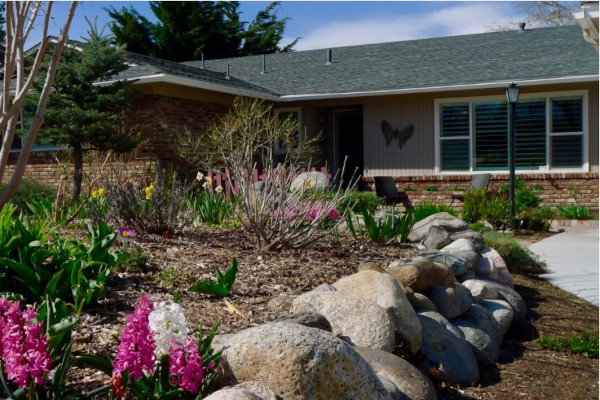
River-Friendly Landscapes can have different aesthetics.
This example highlights drought-tolerant, pollinator plants and retention
of water onsite with thick layers of wood mulch. Carrie Jensen
Why does it matter?
The Truckee River is the lifeblood of our community in the Truckee Meadows, just as the Carson and Walker Rivers are the lifeblood of their communities! Without these rivers, we wouldn’t have water for drinking, for irrigating our yards, for growing our food, or for swimming and recreating in. And did you know that the Truckee River, as well as other rivers in the eastern Sierra and Great Basin, are unique terminal basins, with no water flowing to the ocean? Only about 5% of all watersheds in the world are terminal basins! This accounts for many rare, endemic fish species, like Lahontan cutthroat trout and cui-ui in Pyramid Lake. It also means any pollution that flows into these watersheds stays there, which can have harmful cumulative impacts on plants and wildlife as well as society. And a lot of pollutants come from our landscapes and flow through the storm drain system to our local waterways — like oil from car leaks, soapy water from washing cars in the driveway, sediments, fertilizers, pesticides, and even pet waste.
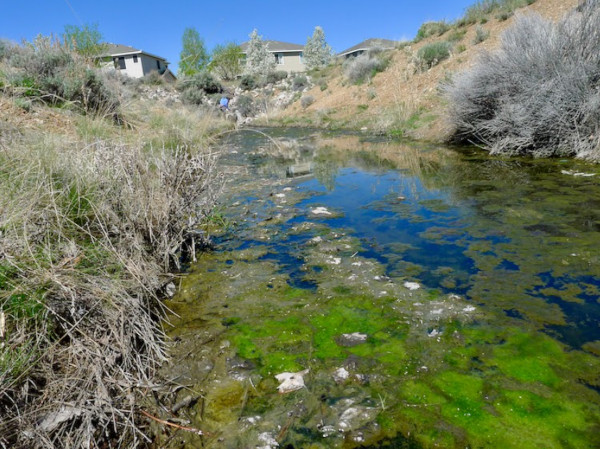
As shown in this drainage in north Reno, pollutants flowing through storm drains can build
up quickly in waterways. Nitrogen and phosphorus from synthetic fertilizers used in the
landscape can contribute to algae blooms, which deplete the water’s oxygen levels when
the algae decays making it difficult for fish and other aquatic species to survive. Carrie Jensen
What can I do?
We all have to work together to protect this special place we call home, and there are lots of things you can do to help keep our watersheds clean. Many of them start right in your yard. That’s where River-Friendly Landscaping comes in!
The Six Principles of River-Friendly Landscaping:
Keep Water Onsite
Soak it up! We live in the high desert, so it's really important to retain as much water as possible in our landscapes and be efficient with its use. Don't let that precious water escape into the storm drain. Instead, use rain gardens, dry swales, rain barrels, and permeable paving to soak up water in your landscape.
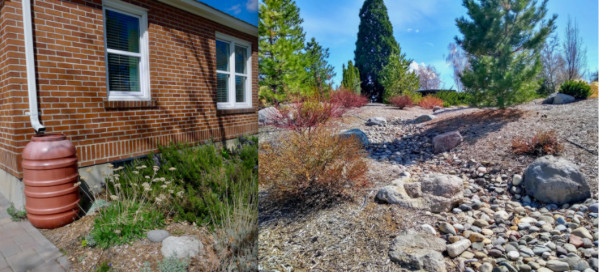
Strategies such as rain barrels (left) and dry swales (right) can be used to soak up water
in your landscape and keep it out of the storm drain system. Carrie Jensen
Reduce Pollutants
We depend on the Truckee River and other rivers of the eastern Sierra for our drinking water supplies. Reducing pollutants in our landscapes helps ensure clean water is flowing to these rivers and out of our taps. To reduce pollutants in our landscapes, try other elements of integrated pest management before resorting to pesticides, prioritize organic fertilizers instead of synthetics, and strive for having living roots in the soil in the off-season to reduce erosion. Prevent accidental spills of fertilizers, pesticides, and other chemicals by storing these items in secure areas.
Use Water Wisely
There’s no denying we live in a desert, but that doesn’t mean you have to remove your entire lawn and limit yourself to rocks and cactus. There are lots of climate appropriate plants to consider, and you can even keep some lawn! Try removing small sections of lawn next to the sidewalk and replace it with drought-tolerant and native plants. This conserves water, supports native pollinators, and ensures we’re not watering the sidewalk with our sprinklers. Consider the irrigation schedule for your River-Friendly Landscape to prevent evaporation during the warmer parts of the day, and for those served by the Truckee Meadows Water Authority, be sure to follow their assigned watering schedule. If you need help with your irrigation system, consider hiring a Qualified Water Efficient Landscaper.
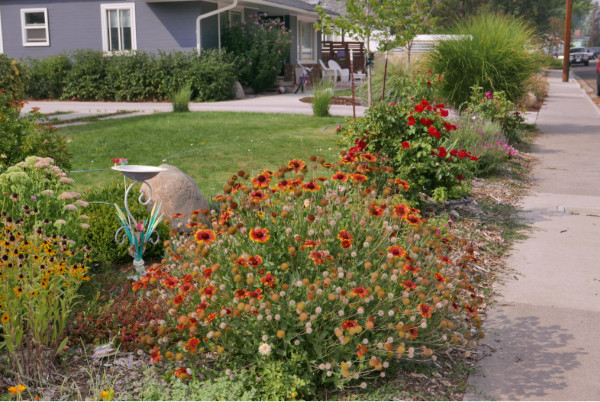
Try planting drought-tolerant plants between the sidewalk and your lawn as a buffer area
that prevents sprinklers from overspraying onto the sidewalk. This conserves
water and protects our waterways from fertilizer pollutants
that can wash off our lawns and into storm drains. Carrie Jensen
Build Healthy Soils
Soil is the foundation on which we build all healthy landscapes. When we foster healthy soils, they support vigorous plants that are less susceptible to disease and pests and require less maintenance. Try using compost and mulch in your yard to increase organic matter, retain soil moisture, and build healthy soils.
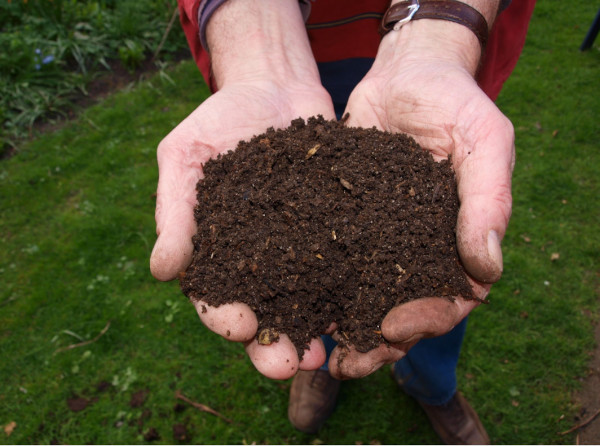
Try using compost as a top dressing to increase the organic matter in your soil.
Not only will it help your soil retain more moisture, it also acts as a slow-release
fertilizer that reduces the need for synthetic fertilizers. Pixabay Photos
Create Wildlife Habitat
While we’re not looking to attract big wildlife like bears and mountain lions, we can share our landscapes with birds and beneficial insects to help promote the biodiversity of our watersheds. Try incorporating a mix of pollinator plants that bloom throughout the growing season, as well as installing bee hotels and nesting boxes for pollinators and birds.
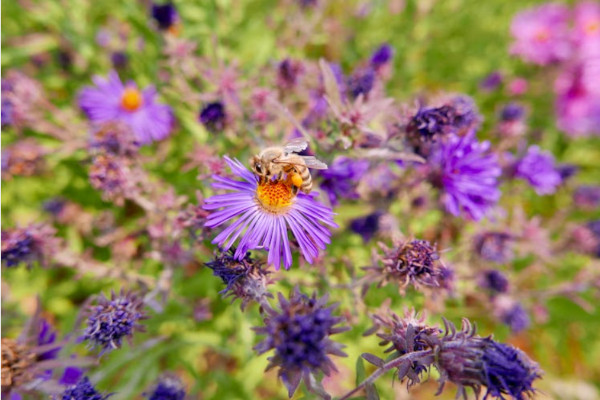
To provide habitat for beneficial insects, you can incorporate plants, like these asters,
that provide nectar and pollen. Carrie Jensen
Prepare for Wildfire
Wildfire is a natural part of the Truckee Meadows and the eastern Sierra ecological cycle. Part of living in this beautiful place is learning to live with fire and managing it in a way that protects our homes and watershed. Be sure to incorporate defensible space, especially if you live on the wildland urban interface.
Learn More
Want to learn more about River-Friendly Landscaping? Sign up for a class! The Sierra Club will be hosting an online introductory course on Feb. 24. Click to register here.